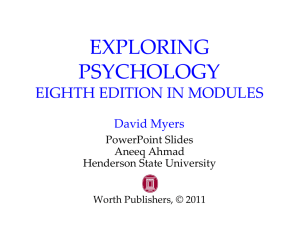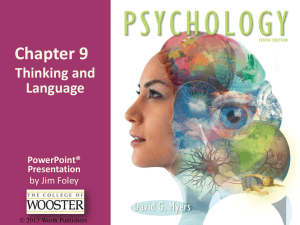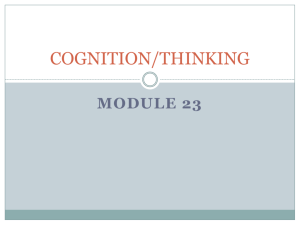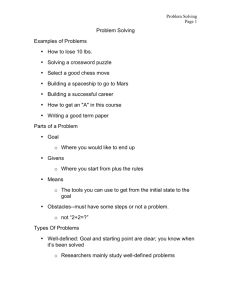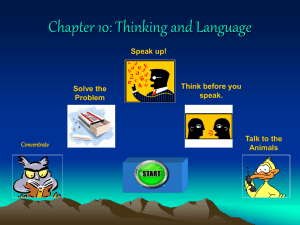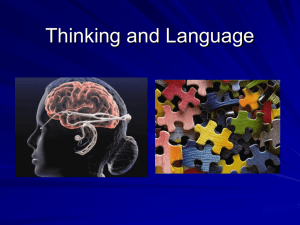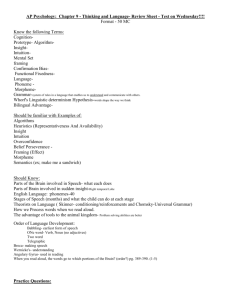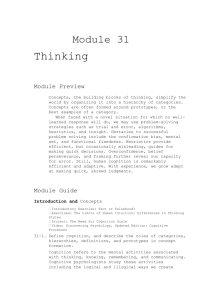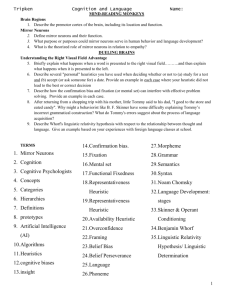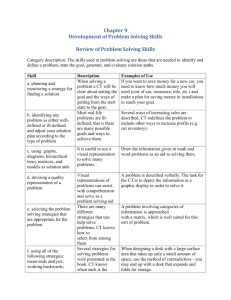Introduction: Thinking, Language, and Intelligence Cognition refers
advertisement
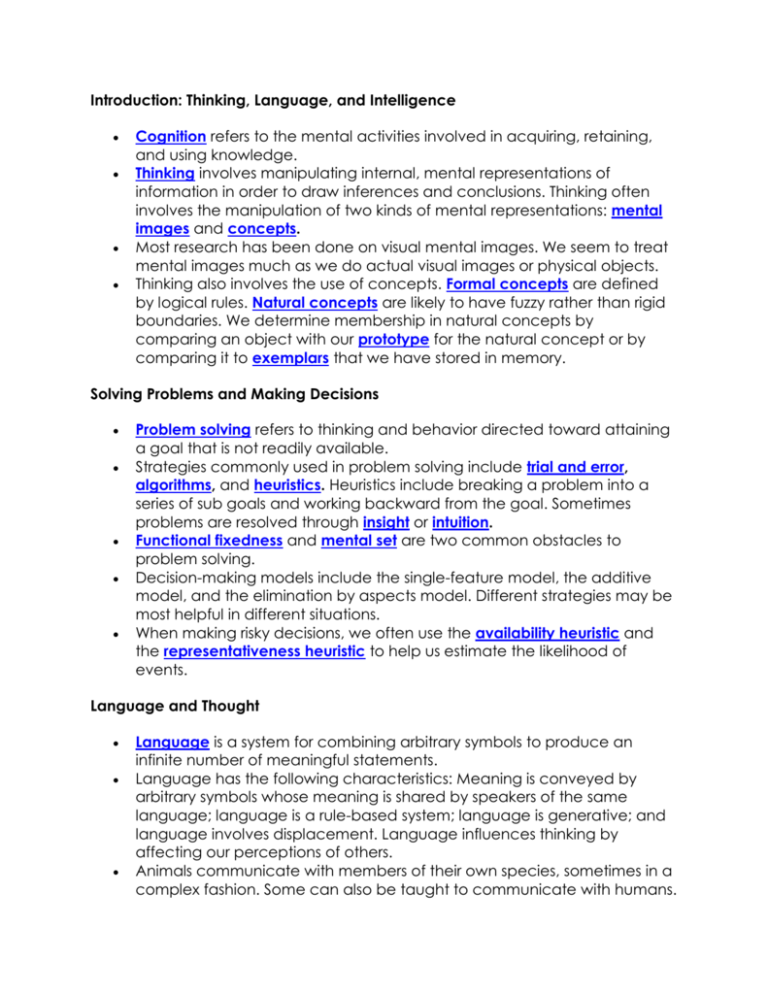
Introduction: Thinking, Language, and Intelligence Cognition refers to the mental activities involved in acquiring, retaining, and using knowledge. Thinking involves manipulating internal, mental representations of information in order to draw inferences and conclusions. Thinking often involves the manipulation of two kinds of mental representations: mental images and concepts. Most research has been done on visual mental images. We seem to treat mental images much as we do actual visual images or physical objects. Thinking also involves the use of concepts. Formal concepts are defined by logical rules. Natural concepts are likely to have fuzzy rather than rigid boundaries. We determine membership in natural concepts by comparing an object with our prototype for the natural concept or by comparing it to exemplars that we have stored in memory. Solving Problems and Making Decisions Problem solving refers to thinking and behavior directed toward attaining a goal that is not readily available. Strategies commonly used in problem solving include trial and error, algorithms, and heuristics. Heuristics include breaking a problem into a series of sub goals and working backward from the goal. Sometimes problems are resolved through insight or intuition. Functional fixedness and mental set are two common obstacles to problem solving. Decision-making models include the single-feature model, the additive model, and the elimination by aspects model. Different strategies may be most helpful in different situations. When making risky decisions, we often use the availability heuristic and the representativeness heuristic to help us estimate the likelihood of events. Language and Thought Language is a system for combining arbitrary symbols to produce an infinite number of meaningful statements. Language has the following characteristics: Meaning is conveyed by arbitrary symbols whose meaning is shared by speakers of the same language; language is a rule-based system; language is generative; and language involves displacement. Language influences thinking by affecting our perceptions of others. Animals communicate with members of their own species, sometimes in a complex fashion. Some can also be taught to communicate with humans. Bonobos and dolphins seem to have demonstrated an elementary grasp of the rules of syntax. Animal cognition is an active field of research in comparative psychology. cognition, p. 291 – The mental activities involved in acquiring, retaining, and using knowledge thinking, p. 291- The manipulation of mental representations of information in order to draw inferences and conclusions mental image, p. 291 – A mental representation of objects or events that are not physically present concept, p. 292 – A mental category of objects or ideas based on properties they share formal concept, p. 294 – A mental category that is formed by learning the rules or features that define it natural concept, p. 294 – A mental category that is formed as a result of everyday experience prototype, p. 294 – the most typical instance of a particular concept exemplars, p. 294 – Individual instances of a concept or category, held in memory problem solving, p. 295 – Thinking and behavior directed toward attaining a goal that is not readily available trial and error, p. 296 – A problem-solving strategy that involves attempting different solutions and eliminating those that do not work algorithm, p. 296 – A problem-solving strategy that involves following a specific rule, procedure, or method that inevitably produces the correct solution heuristic, p. 296 – A problem solving strategy that involves following a general rule of thumb to reduce the number of possible solutions insight, p. 297 – The sudden realization of how a problem can be solved intuition, p. 297 – coming to a conclusion or making a judgement without conscious awareness of the thought processes involved functional fixedness, p. 298 – The tendency to view objects as functioning only in their usual or customary way mental set, p. 298 – the tendency to persist in solving problems with solutions that have worked in the past availability heuristic, p. 300 – a strategy in which the likelihood of an event is estimated on the basis of how readily available other instances of the event are in memory representativeness heuristic, p. 301 – a strategy in which the likelihood of an event is estimated by comparing how similar it is to the prototype of the event language, p. 303 – a system for combining arbitrary symbols to produce an infinite number of meaningful statements linguistic relativity hypothesis, p. 304 – the hypothesis that differences among languages cause differences in the thoughts of their speakers animal cognition, p. 307 – the study of animal learning, memory, thinking, and language; comparative cognition KEY QUESTIONS: 7.1 INTRODUCTION: THINKING, LANGUAGE, AND INTELLIGENCE What are some of the basic characteristics of mental images? o A mental image is a mental representation of objects or events that are not physically present o We rely on them to accomplish some cognitive task o Not strictly limited to visual “pictures” but rather can form images that involve senses other than vision (taste, smell) How do we manipulate mental images? o We manipulate mental images just as we manipulate actual objects o However, our mental images are not identical to the actual images rather they are MEMORIES of visual images so they are subject to potential error What are concepts, and how are they formed? o A concept is a mental category we have formed to group objects, events, or situations that share similar features or characteristics. o Makes it easier to communicate, remember information, and learn new information o Concepts are formed by learning RULES or FEATURES that define the particular concept Formal concept – a mental category that is formed by learning the rules or features that define it Natural concept – concept formed as a result of everyday experience rather than by logically determining whether an object or event fits a specific set of rules. 7.2 SOLVING PROBLEMS AND MAKING DECISIONS What are some advantages and disadvantages of each problem-solving strategy? o TRIAL AND ERROR: A PROCESS OF ELIMINATION Trying a variety of solutions and eliminating those that don’t work Works when there is a limited range of possible solutions Con: can be very time consuming if large range of possible answers o ALGORITHMS: GUARANTEED TO WORK Algorithm: procedure or method that, when followed step by step, always produces the correct solution. Not always practical May work eventually but could take a very long time Pro: Guaranteed to work eventually HEURISTICS: RULES OF THUMB Heuristic: general rule of thumb strategy that may or may not work Simplify problem solving because it reduces the number of possible solutions Serves an adaptive purpose by allowing the use of patterns of information to solve problems quickly and accurately Subgoals – common heuristic involves breaking things down into a series of subgoals; solving each sub problem moves you closer to solving the larger problem Working backward – starting with the end point you can determine steps necessary to reach final goal Flexibility – recognize that a particular strategy is unlikely to yield a solution and switch to a different approach INSIGHT AND INTUITION Insight – solution appears as a sudden realization or flash after mulling it over Usually not aware of thought processes that lead to insight Intuition – coming to a conclusion or making a judgment without conscious awareness of the though process involved 2 stage model: o o GUIDING STAGE: you perceive a pattern in the information you’re considering but not consciously; based on your expertise and your memories INTEGRATIVE STAGE: representation of the pattern becomes conscious (hypothesis) and conscious analytic processes take over. Intuitive hunch – new idea that integrates new information with existing knowledge stored in long-term memory What is insight, and how does intuition work? o See Above How can functional fixedness and mental set interfere with problem solving? o Functional fixedness: view objects as functioning only in the usual or customary way. Prevents us from seeing the full range of ways an item can be used o Mental set: tendency to persist in solving problems with solutions that have worked in the past Also obscures our ability to see other solutions Blocks insight in areas in which you are already knowledgeable or well trained 7.2.3 DECISION-MAKING STRATEGIES What are the single-feature model, the additive model, and the elimination by aspects model of decision making? Under what conditions is each strategy most appropriate? How do we use the availability and representativeness heuristics to help us estimate the likelihood of an event?
